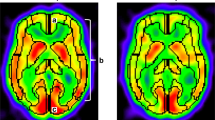Abstract
Regional cerebral blood flow (rCBF) and its reactivity to acetazolamide were analyzed in a series of 15 cases of childhood moyamoya disease, using the xenon-133 inhalation method and single photon emission CT (SPECT). Most of the patients had normal mean hemispheric cerebral blood flow (mCBF), comparable to that of age-matched healthy children. However, they had abnormal rCBF distribution and disturbed reactivity to acetazolamide in the territory of the internal carotid artery, especially in the frontal lobe. Surgical revascularization for the anterior circulation, which consisted of STA-MCA anastomosis and indirect synangiosis, dramatically improved theses cerebral hemodynamics in the anterior circulation, including the frontal lobe, and reactivity to acetazolamide in the whole brain. These results suggest that surgical revascularization for the anterior circulation should be carried out in order to improve cerebral hemodynamics as widely as possible, especially in the frontal lobe, and may improve cerebral perfusion reserve in the posterior circulation.
Similar content being viewed by others
References
Abe H, Kamiyama H (1987) Surgical treatment of the spontaneous occlusion of the circle of Willis (in Japanese). In: Annual Report 1986 of the Research Committee on Spontaneous Occlusion of the Circle of Willis. Ministry of Health and Welfare, Japan, pp 37–42
Abe H, Kamiyama T, Takikawa S, Kuroda S, Yamauchi T (1990) Intellectual development of children with moyamoya disease (in Japanese). In: Annual Report 1989 of the Research Committee on Spontaneous Occlusion of the Circle of Willis. Ministry of Health and Welfare. Japan, pp 126–132
Ejiri T, Endo H, Kubo H, Kanaya H (1986) Regional cerebral blood flow of moyamoya disease in the chronic state as studied using a three-dimensional method — with special reference to CO2 response and autoregulation (in Japanese). CT Kenkyu 8:15–26
Gotoh F, Meyer J, Tomita M (1966) Carbonic anhydrase inhibition and cerebral venous gases and ion in man. Arch Intern Med 117:39–46
Gotoh F, Fukuuchi Y, Takashima S, Kawamura J, Terayama Y (1987) Local cerebral blood flow and CO2 responsiveness in patients with „moyamoya disease” (in Japanese). In: Annual Report 1986 of the Research Committee on Spontaneous Occlusion of the Circle of Willis. Ministry of Health and Welfare, Japan, pp 78–87
Hauge A, Nicolaysen G, Thoresen M (1983) Acute effect of acetazolamide on cerebral blood flow in man. Acta Physiol Scand 117:233–239
Heuser D, Astrup J, Lassen N (1975) Brain carbonic acidosis after acetazolamide. Acta Physiol Scand 93:385–390
Isobe M, Kuroda S, Kamiyama H, Abe H, Mitsumori K (1992) Cerebral blood flow reactivity to hyperventilation in children with spontaneous occlusion of the circle of Willis (moyamoya disease) (in Japanese). No Shinkei Geka 20:399–407
Kanno I, Lassen N (1979) Two methods fro calculating cerebral blood flow from emission tomography of inert gas concentration. J Comput Assist Tomogr 3:71–76
Karasawa J, Kikuchi H, Furuse S, Kawamura J, Sakaki T (1978) Treatment of moyamoya disease with STA-MCA anastomosis. J Neurosurg 49:679–688
Karasawa J, Touho H, Ohnishi H, Miyamoto S, Kikuchi H (1992) Long-term follow-up study after extracranial-intracranial by pass surgery for anterior circulation ischemia in childhood moyamoya disease. J Neurosurg 77:84–89
Kuroda S, Kamiyama H, Abe H, Houkin K, Isobe M, Mitsumori K (1993) Acetazolamide test in detecting reduced cerebral perfusion reserve and predicting long-term prognosis in patients with internal carotid artery occlusion. Neurosurgery 32:912–919
Kuroda S, Kamiyama H, Isobe M, Houkin K, Abe H, Mitsumori K (1995) Cerebral hemodynamics and “re-build-up” phenomenon on electroencephalogram in children with moyamoya disease. Child's Nerv Syst 11:214–219
Kuwabara Y, Ichiya Y, Otsuka M, Tahara T, Gunasekera R, Hasuo K, Masuda K, Matsushima T, Fukui M (1990) Cerebral hemodynamic change in the child and the adult with moyamoya disease. Stroke 21:272–277
Kuyama H, Niimi H, Kawauchi M, Tanimoto T, Murota T, Kinugasa K, Asari S, Nishimoto A, Nagao S (1988) Hemodynamic changes after vascular reconstructive surgery for moyamoya disease (in Japanese). CT Kenkyu 10: 317–322
Matsushima T, Inoue T, Suzuki S, Fujii K, Fukui M, Hasuo K (1992) Surgical treatment of moyamoya disease in pediatric patients — comparison between the results of indirect and direct revascularization procedures. Neurosurgery 31:401–405
Ogawa A, Nakamura N, Yoshimoto T, Suzuki J (1990) Cerebral blood flow in moyamoya disease. II. Autoregulation and CO2 response. Acta Neurochir (Wien) 105:107–111
Ogawa A, Yoshimoto T, Suzuki J, Sakurai Y (1990) Cerebral blood flow in moyamoya disease. I. Correlation with age and regional distribution. Acta Neurochir (Wien) 105:30–34
Sato H, Sato N, Tamaki N, Matsumoto S (1990) Chronic low-perfusion state in children with moyamoya disease following revascularization. Child's Nerv Syst 6:166–171
Suzuki R, Tsuruoka S, Hiratsuka H, Matsushima Y, Fukumoto T, Inaba Y, Ohno K (1985) Cerebral circulation in pediatric patients with moyamoya disease (in Japanese). Neurol Med Chir (Tokyo) 25:969–974
Takahashi A, Kamiyama H, Houkin K, Abe H (1995) Surgical treatment of childhood moyamoya disease-comparison between thereconstructive surgery centered on the frontal region and that centered on the parietal region. Neurol Med Chir (Tokyo) (in press)
Takeuchi S, Tanaka R, Ishii R, Tsuchida T, Kobayashi K, Arai H (1985) Cerebral hemodynamics in patients with moyamoya disease. A study of regional cerebral blood flow by the 133Xe inhalation method. Surg Neurol 23:468–474
Takikawa S, Kamiyama H, Abe H, Mitsumori K, Tsuru M (1990) Hemodynamic evaluation of vascular reconstructive surgery for childhood moyamoya disease using single photon emission computed tomography. Neurol Med Chir (Tokyo) 30:389–395
Vorstrup S, Brun B, Lassen N (1986) Evaluation of the cerebral vasodilatory capacity by the acetazolamide test before EC/IC bypass surgery in patients with occlusion of the internal carotid artery. Stroke 17:1291–1298
Author information
Authors and Affiliations
Rights and permissions
About this article
Cite this article
Kuroda, S., Houkin, K., Kamiyama, H. et al. Regional cerebral hemodynamics in childhood moyamoya disease. Child's Nerv Syst 11, 584–590 (1995). https://doi.org/10.1007/BF00300997
Received:
Issue Date:
DOI: https://doi.org/10.1007/BF00300997




